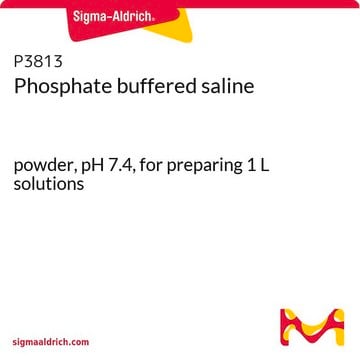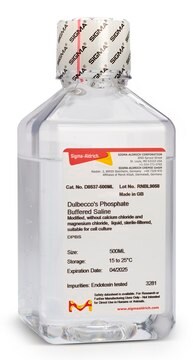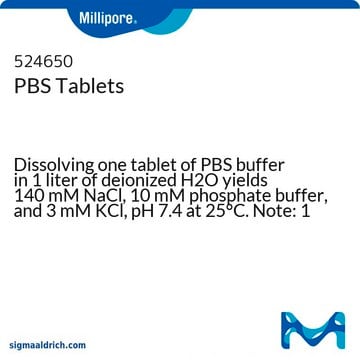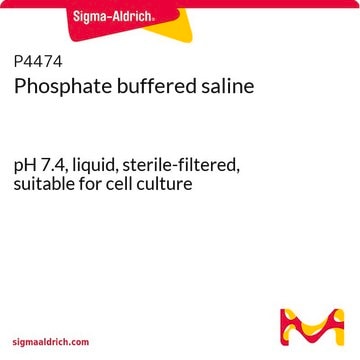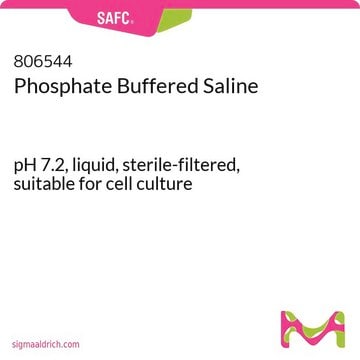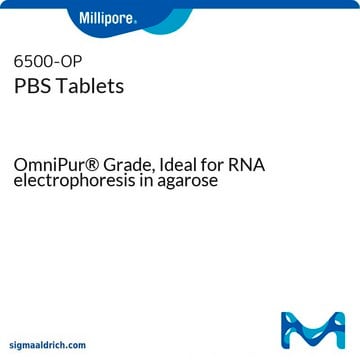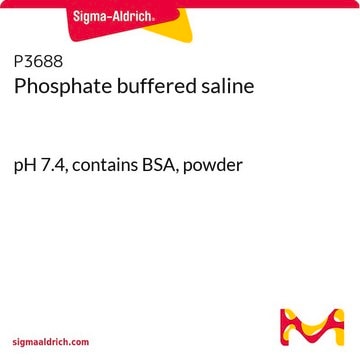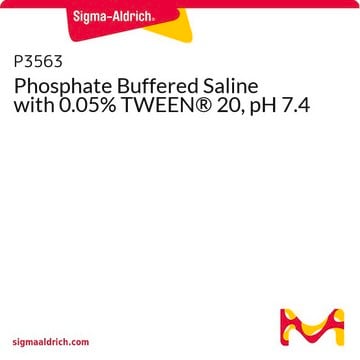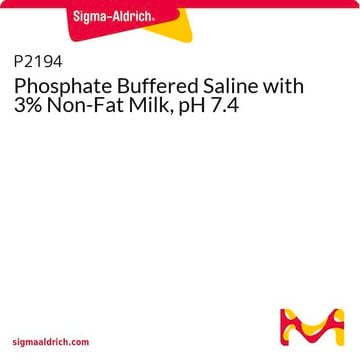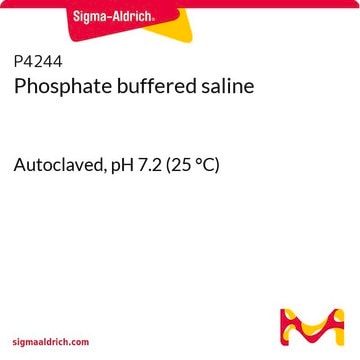Each tablet of this product should weigh between 1814.5 and 2005.5 milligrams.
P4417
Phosphatgepufferte Kochsalzlösung -Lösung
tablet, pH 7.2-7.6 (1 tablet/200 mL)
Synonym(e):
PBS
Größe auswählen
About This Item
Empfohlene Produkte
Produktbezeichnung
Phosphatgepufferte Kochsalzlösung -Lösung, tablet
Form
tablet
Qualitätsniveau
Lagerbedingungen
dry at room temperature
Farbe
white
pH-Wert
7.2-7.6 (1 tablet/200 mL)
Löslichkeit
water: soluble
Dichte
1.02 g/cm3 at 20—25 °C
1.03 g/cm3 at 20—25 °C
Anwendung(en)
diagnostic assay manufacturing
histology
life science and biopharma
Suchen Sie nach ähnlichen Produkten? Aufrufen Leitfaden zum Produktvergleich
Allgemeine Beschreibung
Über die Zellbiologie hinaus zeichnet sich PBS durch Vielseitigkeit in Anwendungen wie etwa der Entwicklung individueller ELISA-Puffer für optimale Antikörper-Antigen-Interaktionen aus. Darüber hinaus dient es als Laufpuffer für die Protein A/G-Chromatographie und erleichtert die Antikörper-Aufreinigung auf der Grundlage einer spezifischen Antigenbindung. Bei hämatologischen und biochemischen Verfahren spielt PBS eine entscheidende Rolle beim effektiven Waschen von Zellen und Gewebe. Insgesamt hat sich PBS sowohl in der biologischen als auch in der biochemischen Forschung als unverzichtbares Hilfsmittel erwiesen und bietet Isotonizität, Pufferkapazität, Einfachheit und Stabilität. Seine vielfältigen Anwendungen in der Zellbiologie, bei der Reagenzzubereitung, bei der Proteinaufreinigung und in verschiedenen biologischen Assays unterstreichen seine zentrale Bedeutung für den Fortschritt in der Wissenschaft.
Anwendung
- Produktion von Platin-Nanopartikel(Pt-NP)-Hydrokolloiden[1]
- Waschen von Blutproben und REM (Rasterelektronenmikroskop)-Probenträgern vor der REM[1]
- Herstellung von Lösungen des fluoreszierenden Lektins Weizenkeim-Agglutinin (WGA)[2]
- Verdünnung des Fänger-Antikörpers im Verlauf von ELISA (Enzyme-linked Immunosorbent Assay)[3]
- Suspension von Zellpellets bei der Zentrifugation[3]
- Immunassays
Leistungsmerkmale und Vorteile
- Hochwertiges Produkt, das für zahlreiche Forschungsanwendungen geeignet ist
- Kann als Pufferkomponente in biologischen und biochemischen Anwendungen verwendet werden
- Sehr gut wasserlöslich
Rekonstituierung
Sonstige Hinweise
Empfehlung
auch häufig zusammen mit diesem Produkt gekauft
Lagerklassenschlüssel
13 - Non Combustible Solids
WGK
WGK 1
Flammpunkt (°F)
Not applicable
Flammpunkt (°C)
Not applicable
Hier finden Sie alle aktuellen Versionen:
Analysenzertifikate (COA)
Die passende Version wird nicht angezeigt?
Wenn Sie eine bestimmte Version benötigen, können Sie anhand der Lot- oder Chargennummer nach einem spezifischen Zertifikat suchen.
Besitzen Sie dieses Produkt bereits?
In der Dokumentenbibliothek finden Sie die Dokumentation zu den Produkten, die Sie kürzlich erworben haben.
Kunden haben sich ebenfalls angesehen
Artikel
Ensure optimal cell culture outcomes with ultrapure, endotoxin-free water. Learn about the impact of water impurities on mammalian cell cultures and how to achieve optimal cell growth.
Protokolle
Antibody purification protocols yield preparations containing endogenous IgG alongside specific antibodies.
Cell staining can be divided into four steps: cell preparation, fixation, application of antibody, and evaluation.
Detailed ELISA protocols cover indirect and capture ELISA techniques, recommending products for sandwich and indirect ELISA experiments.
Techniques for protein antigen molecular weight determination, protein interactions, enzymatic activity, and post-translational modifications.
-
How much should one tablet weigh for it to yield 200ml 1xPBS? Asking just to make sure we won't use chipped tablets.
1 Antwort-
Hilfreich?
-
-
How can I determine the shelf life / expiration / retest date of this product?
1 Antwort-
If this product has an expiration or retest date, it will be shown on the Certificate of Analysis (COA, CofA). If there is no retest or expiration date listed on the product's COA, we do not have suitable stability data to determine a shelf life. For these products, the only date on the COA will be the release date; a retest, expiration, or use-by-date will not be displayed.
For all products, we recommend handling per defined conditions as printed in our product literature and website product descriptions. We recommend that products should be routinely inspected by customers to ensure they perform as expected.
For products without retest or expiration dates, our standard warranty of 1 year from the date of shipment is applicable.
For more information, please refer to the Product Dating Information document: https://www.sigmaaldrich.com/deepweb/assets/sigmaaldrich/marketing/global/documents/449/386/product-dating-information-mk.pdfHilfreich?
-
-
How is shipping temperature determined? And how is it related to the product storage temperature?
1 Antwort-
Products may be shipped at a different temperature than the recommended long-term storage temperature. If the product quality is sensitive to short-term exposure to conditions other than the recommended long-term storage, it will be shipped on wet or dry-ice. If the product quality is NOT affected by short-term exposure to conditions other than the recommended long-term storage, it will be shipped at ambient temperature. As shipping routes are configured for minimum transit times, shipping at ambient temperature helps control shipping costs for our customers. For more information, please refer to the Storage and Transport Conditions document: https://www.sigmaaldrich.com/deepweb/assets/sigmaaldrich/marketing/global/documents/316/622/storage-transport-conditions-mk.pdf
Hilfreich?
-
-
If I want to make the same buffer molarity as the product P4474-1L, how many tablets should I dissolve in 1L of DI water?
1 Antwort-
P4417 and P4474 have different components and initial concentrations. One P4417 tablet dissolved in 200 mL of deionized water yields a 0.01 M phosphate buffer, 0.0027 M potassium chloride, and 0.137 M sodium chloride at pH 7.4, 25 °C. P4474 contains 1.058 mM potassium phosphate monobasic, 154 mM sodium chloride, and 2.97 mM sodium phosphate dibasic dihydrate. Due to these differences, it is not feasible to directly match the molarity of P4474 by dissolving P4417 tablets.
Hilfreich?
-
-
Going by instructions, 1 tab in 200 mL water gives a 1x PBS sol'n. The recipe I use for 1x PBS has the same salt concs. Sorry if this is a silly question, but can I make up a 3x PBS solution simply by dissolving 3 tablets in 200 mL of water?
1 Antwort-
These tablets have not been tested for solubility or dissolution time at a 3X concentration. The end user would have to determine solubility experimentally. Note that 10X prepared solutions are available and may easily be diluted to the desired concentration. Please see the link below to review several of these product options:
https://www.sigmaaldrich.com/search/pbs-10x?focus=products&page=1&perpage=30&sort=relevance&term=PBS%2010X&type=productHilfreich?
-
-
Hi! If with this product I want to do a 10x solution, do i dilute it in 2000 mL or first in 200mL and then do the dilution? Thanks!
1 Antwort-
Dissolve 1 tablet in 200 ml of water to obtain: 0.01 M phosphate buffer, 0.0027 M potassium chloride and 0.137 M sodium chloride, pH 7.4 At 25 °C. These instructions are for a 1 X PBS preparation and this product is only intended for this specific concentration. If a 10X concentrate is needed, there are options in the catalog, such as the following products : 79383, P7059, 6506-OP, and 6505-OP.
Hilfreich?
-
-
Is it possible to obtain the salt components for product 6501-200TAB? Additionally, can you provide the composition details for other PBS tablets or powder products?
1 Antwort-
The compositions are as follows:
1. 6501-200TAB: This PBS contains 137mM NaCl, 2.7 mM KCl, and 10mM Na phosphate.
2. P3813 - powder - Packed in Pouch or PAK: Each pouch contains 8 g Sodium Chloride, 0.2 g Potassium Phosphate, monobasic, 1.15 g Sodium Phosphate, dibasic, and 0.2 g Potassium Chloride, totaling 9.55 g per packet. This is a standard PBS formulation.
3. P4417- Tablet: When dissolved in 200 mL of deionized water, one tablet yields 0.01 M phosphate buffer, 0.0027 M potassium chloride, and 0.137 M sodium chloride, at pH 7.4 and 25 °C. This product contains the same formulation as P3813 on a per liter basis (excluding tableting fillers): 8 g/L Sodium Chloride, 0.2 g/L Potassium Phosphate, monobasic, 1.15 g/L Sodium Phosphate, dibasic, and 0.2 g/L Potassium Chloride. This mixture should be diluted to one liter of water, resulting in a pH of 7.4, which can be adjusted using phosphoric acid or sodium hydroxide. The concentrations are 10 mM phosphate buffer, 2.7 mM potassium chloride, and 137 mM. These PBS tablets do not contain BSA.
Hilfreich?
-
-
What is the osmolality of P4417 made to 1X PBS at pH 7.4?
1 Antwort-
This PBS once diluted in 200 mL distilled water will account for:
2.7 mM potassium chloride = 5.4 mosmoles / L
137 mM sodium chloride = 274 mosmoles / LThe exact osmolality is not determined.
Hilfreich?
-
-
Is this PBS calcium-free?
1 Antwort-
The formulation of this product is considered proprietary. However, calcium is not included in the composition.
Hilfreich?
-
-
What is the purity and CAS
1 Antwort-
This product is a mixture of components. CAS numbers are not assigned to multi-component products. Likewise, as there are multiple components, purity is not reported. Upon reconstitution according to instructions, the solution will contain 0.01 M phosphate buffer, 0.0027 M potassium chloride, and 0.137 M sodium chloride.
Hilfreich?
-
Aktive Filter
Unser Team von Wissenschaftlern verfügt über Erfahrung in allen Forschungsbereichen einschließlich Life Science, Materialwissenschaften, chemischer Synthese, Chromatographie, Analytik und vielen mehr..
Setzen Sie sich mit dem technischen Dienst in Verbindung.